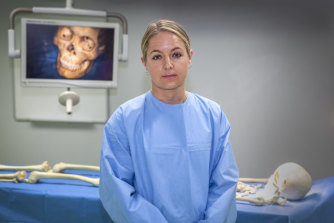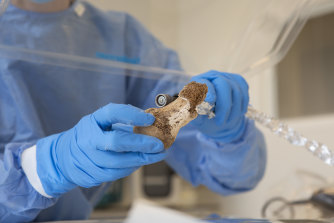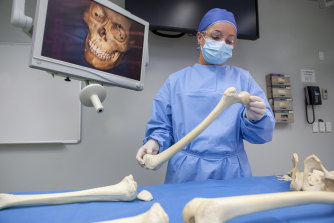Key points
- Scientists at the National Missing Persons Coordination Centre say online DNA collection databases have the potential to help solve cases.
- People can help by consenting to their DNA being used and by uploading results to sites that Australian authorities can access.
- Genetic genealogy testing made headlines in the US in 2018 after police used DNA databases and online family trees to find potential suspects in the Golden State Killer case, leading to the arrest and conviction of Joseph James DeAngelo.
- Experts warned against providing genetic data to online genealogy sites that don’t clearly explain how that information could be used.
Genetic genealogy websites are being used by law enforcement agencies to help solve missing person cases as scientists tap into new technologies to help unmask some of Australia’s 750 unidentified remains.
Scientists at the Australian Federal Police National Missing Persons Coordination Centre say online DNA collection databases have the potential to help solve cases here after successfully helping decode hundreds of remains in other countries including the US.
Jodie Ward, associate professor at the National Missing Persons Coordination Centre.
“Many of these cases date back to the ’50s and ’60s … so time is against us,” Associate Professor Jodie Ward said.
“Opening up the field of possible comparison samples to the general public, using these genetic genealogy databases, gives us this global reach we’ve never had before.”
More than 2500 Australians are currently classified as long-term missing persons, with new unidentified remains frequently making their way to the purpose-built forensic centre launched in Canberra in December.
Ward, an internationally renowned forensic DNA specialist working at the centre, said the problem was some families, particularly in historical cases, were unaware that a distant family member was waiting to be identified.
People could help to solve those cases by consenting to their DNA being used and by uploading results they had already obtained on popular online genealogy sites to sites that Australian authorities can access, she said
Those currently accessible for the sole purpose of helping solve missing persons cases in Australia included GEDmatch Pro, FamilyTreeDNA and DNASolves, she said.
By doing so, Ward said Australians could help unlock answers about a missing relative they never knew about.
“It’s provided resolution for hundreds of cases in the US, and we want to apply it to unsolvable human-remains cases here,” she said. “We’re actively using it and one case has already been submitted for testing.”
The AFP testing unidentified human remains using cutting-edge technology to help solve some of Australia’s most enduring missing persons’ cases.
The use of genetic genealogy testing made headlines in the US in 2018 after police searched DNA databases and online family trees to find potential suspects in the Golden State Killer case.
It led to the arrest and conviction of Joseph James DeAngelo more than 40 years after his victims were attacked and killed across California.
Ward said that in Australia, DNA technology could only be used by authorities for missing persons cases, and family members must provide informed consent.
“For many people, there is misconception that you’ve taken one of these DNA tests and found out you’re 50 per cent European, and you’ve found a second cousin, that now my DNA could be being used for law enforcement. It isn’t that easy, active steps need to be taken,” she said.
Ward examining skeletal remains at the AFP forensic facility in Canberra.
Speaking as part of National Missing Persons Week, Ward said genetic genealogy technology was just one of the new measures being used by the country’s National DNA Program for Unidentified and Missing Persons, which was recently extended until the end of 2023.
Craniofacial construction capability, which estimates the facial appearance of a person from a single bone, arrived in the country last month. Scientists also now use forensic DNA phenotyping that can determine a person’s hair and eye colour from their remains.
Ward said she hoped the dedicated unit would continue to solve cases, with five people already identified since it launched in 2020.
One of these is Mario Della Torre, missing since 1976, whose identity was confirmed by the South Australian Coroner in February following testing of bones found at False Bay in 1977.
Deakin Law School Associate Professor Shiri Krebs warned people to be wary of providing their data to any online genealogy site with obscure privacy policies.
She said it was imperative that genetic data collection sites offered easy-to-understand terms and conditions, so users were aware of how their information could be used. Any that didn’t should raise red flags for users, Krebs said.
Liberty Victoria president Michael Stanton said the country was facing a new frontier in the collection and use of DNA and warned people to approach with caution.
He said the increasing use of this technology should also give rise to questions about how this information could be used intergenerationally.
“It’s important people are conscious of the fact that it is possible in the future that this sort of information could be used for the investigation of not just missing persons, but also criminal offences,” Stanton said.
For more information visit missingpersons.gov.au.
Liam Mannix’s Examine newsletter explains and analyses science with a rigorous focus on the evidence. Sign up to get it each week.
Most Viewed in Politics
From our partners
Source: Read Full Article



